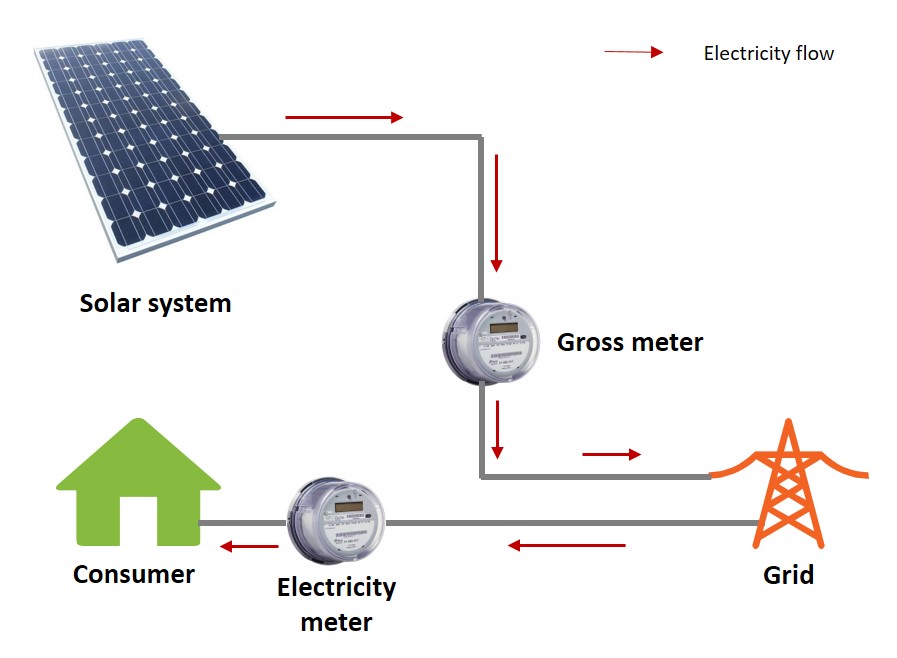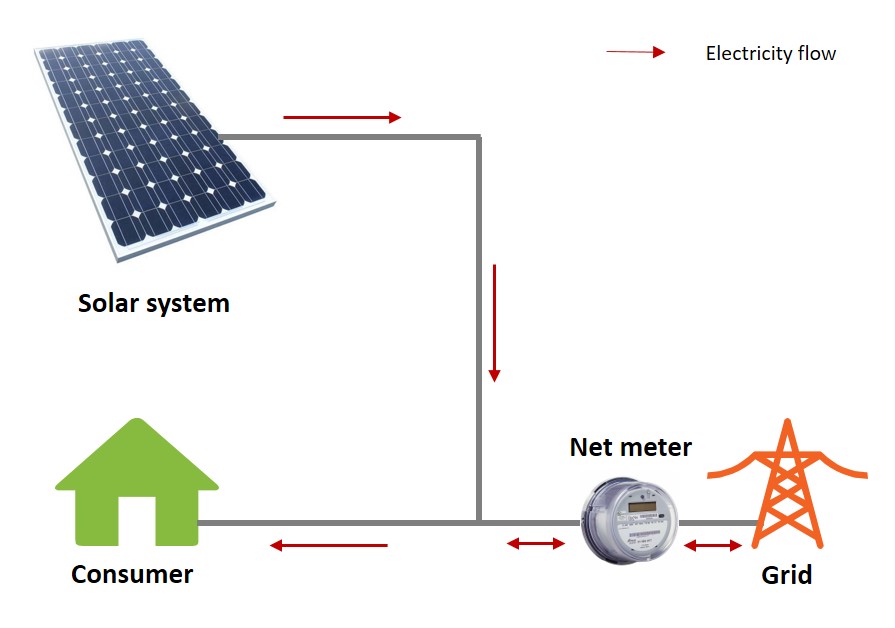Context
Generating electricity is easier than ever. Drastic price decline in the last decade, combined with policy incentives for rooftop systems, have allowed consumers to install solar system on their rooftop. However, given that it is expensive to store electricity, systems are often connected to the grid so that surplus can be exported to the grid and deficit can be imported from the grid. Two arrangements are often defined by governments when designing the regulations for solar rooftop system – Gross and Net metering.
Gross metering is an arrangement in which a consumer is compensated at a fixed feed-in-tariff for the total number of units of solar energy generated and exported to the grid (accounted by a unidirectional ‘gross meter’) and has to pay the electricity distribution company (discom) at retail supply tariff for the electricity consumed from the grid. The feed-in-tariff and retail supply tariff are typically different rates.
Figure 1: Gross metering

Net metering is an arrangement in which electricity exports are adjusted against imports, lowering the electricity bill, such that, electricity produced is deducted from the total electricity consumed over a fixed period of time. The adjustment may be done either on a monthly, half-yearly or annual basis. Typically, a bidirectional ‘net meter’ accounts for both import and export of power. If the exported electricity is higher than the imported electricity, a consumer may or may not be compensated for the excess electricity being fed into the grid (depending up a state’s net metering policy).
Figure 2: Net metering

Relevance & Impact
With increasing awareness and availability of new business models, more and more consumers are adopting rooftop solar systems. In the current context while many distribution companies are inclined to discourage rooftop installations due to potential revenue loss, few have proposed to shift from net metering to gross metering. This is because under the gross metering arrangement, compensation to consumers is typically lower than the retail supply tariff (at which they buy electricity from discoms). While, under net metering since import of power is adjusted against the export, the compensation is effectively at retail supply tariff. Therefore, as a revenue protection measure, they are inclined to adopt gross metering instead of net metering[1]. However, there may be exceptions and consumers should understand the benefit and impact before choosing net or gross metering for their solar rooftop system (if discom provides the option).
Who should care
- Potential solar rooftop consumers
- Distribution companies and State Electricity Regulatory Commissions
- Rooftop solar developers
Case study
In order to explain gross metering, a 2 kW rooftop solar system (that generates 288 kWh per month on average[2]) installed by a domestic consumer has been assumed. The applicable tariff slab is captured in Table 1 and average cost of supply (ACoS) at which the consumer is compensated for export of power has been assumed as INR 5.90/kWh[3].
Table 1: Retail supply tariff for Andhra Pradesh 2018-19

Table 2 illustrates net monthly payment for a domestic consumer for gross metering.
Table 2: Net monthly payment by customer for gross metering

Table 3 illustrates net monthly payment for a domestic consumer for net metering. In case of net export, it has been assumed that the discom shall compensate the consumer at ACoS of INR 5.90/kWh.
Table 3: Net monthly payment by customer for net metering

References
- [1] MSEDCL (Maharashtra’s state discom) in its petition for FY 2019-20 proposed gross metering instead of net metering. Source: https://www.mahadiscom.in/wp-content/uploads/2018/07/MSEDCL-MTR-Petition-Searchable-Format.pdf
- [2] Source: Net metering and gross metering, NREDCAP. https://pmsuryaghar.gov.in/
- [3] Source: APERC tariff order 2018-19. http://aperc.gov.in/admin/upload/TO2018-19.pdf


